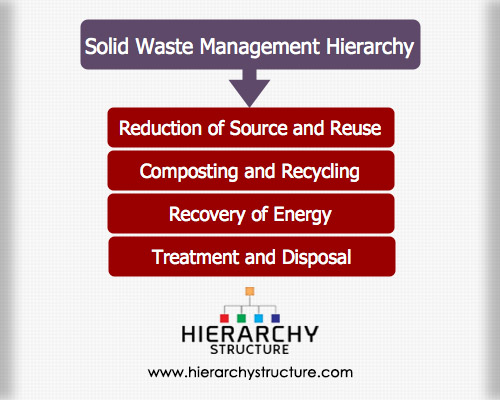Various types of waste, collected generally in the urban area are known as solid waste. There are two types of urban wastes, organic and inorganic. Among the organic waste again, there are three divisions, putrescible, which decomposes quickly, with bad odor and bad visual image.
Fermentable that decomposes rapidly, but does not emit foul odor. And, non-fermentable that decomposes very slowly. The phrase waste management hierarchy indicates a preference for the management and reduction of the waste. The hierarchy demonstrates how a material progresses through various stages of waste management, along with the last section of the life cycles of the same product.
A good solid waste management system needs to be put in place, because without this, the situation can become uncontrollable at a later period. A nation’s production of waste increases with its development, and thus, waste management is a very important step for any country.
Waste hierarchy is important because, its purpose is to obtain highest amount of benefit from a product and lowest possible waste. Waste management can be of a huge advantage, as, managing of waste means there will be less amount of greenhouse gas emission, reduction in pollutants, etc.
The waste management hierarchy has mainly 4 steps, from top to bottom, reduction of source and reuse, composting and recycling, recovery of energy, and treatment and disposal.

Reduction of Source and Reuse
Reduction of source is also called waste prevention and it means that wastage of things are reduced right at the source. There can be various ways of reducing the waste, such as, reusing old items, donating them, less use of packaging, reducing the toxicity, among other things. Reuses, lightweight packaging etc are helpful in the business enterprises. There are certain advantages of this, such as, reducing pollution and helping in saving natural energy, conserves energy, and even saves money.
Composting and Recycling
Recycling is one such activity, which can involve various acts such as, collection of those items which would be considered as waste, sorting them according to their use, they can be used, reused, or unused, and then processing them into a raw material, out of which something new is manufactured. Composting of food scraps and other organic material can also lead to recycling. The main benefits of recycling are, energy saving management, supplying raw materials to industries, preventing the emission of greenhouse gas, and some other natural pollutants, and even creation of jobs.
Recovery of Energy
Not all materials are recyclable, yet they can be used, for generation of heat, electricity, or fuel. There are various ways for it, such as, pyrolization, combustion, gasification, etc.
Treatment and Disposal
Treating the waste before disposing it reduces the amount of toxicity that the waste contains. Treatments can be biological, physical, or chemical. The most common form of disposal of waste is landfill, and most modern landfill is well-engineered and regulated areas. There are certain standards that the landfills must meet in order to remain open.
Thus, this is in a nutshell a solid waste management hierarchy.
